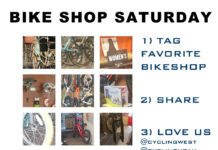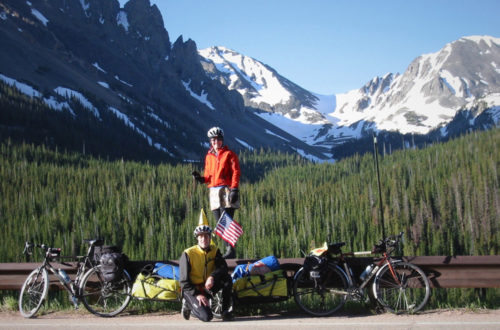
By Lou Melini
To travel by bike alone, with one other person, or with a group is one of several decisions one has to make when going on a relatively long bike tour. For married couples the decision should be easy, but for a number of reasons, traveling together on a bike tour, even for a few days, simply does not happen for a lot of cycling couples. Don and Angie Vincent is one couple that have made the commitment and have traveled together on bikes for over 8,000 miles in the past 6 years, enjoying every moment-well almost every moment.
Cycling Utah: How did you get started bicycle touring and what are some of the best trips that you have done?
Don and Angie Vincent: Angie and I have enjoyed biking for a long time and when Angie retired from the Air Force (I had retired a few years before that), we started biking more and for longer distances. About that time, you and Cheryl Soshnik organized the first overnighter to Rockcliff that gave cyclists that have not traveled overnight by bike an easy trip to gain some experience and learn from those that have traveled by bike. That was our first trip. That same year Cheryl got us on a RAGBRAI (Register’s Annual Great
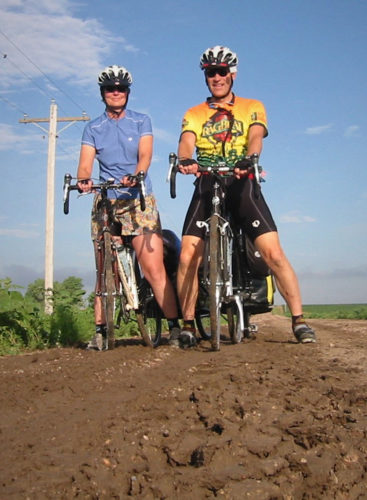
Bike Ride Across Iowa), party that was a week long supported trip. That was all it took for us to get hooked on touring. The following year we again biked to you and Cheryl’s overnighter at Rockcliff and just kept riding…all the way to the East coast in Georgia. Our trip to Georgia was our first true self-supported trip. It turned into a 3,700-mile; 77-day; 10-state ride! Our biggest and “bestest” rides were the 2700-mile Great Divide Mountain Bike Route and the before mentioned ride to Georgia; both were self-supported which means no cars were involved in those trips. We’ve done a lot of smaller rides, some supported and some self-supported. This summer we rode 520 awesome miles of self-supported back roads and trails on the Idaho Hot -Springs Mountain Bike Route. (Maps can be obtained through Adventure Cycling and see the May 2015 issue of Cycling Utah for a report by Lou Melini)
C.U.: What makes traveling as a couple special?
D & A: All in all, we really enjoy each other’s company and are happy to have someone to share the journey with. Angie and I have been married for 29 years and have been actively bike touring for 6 years and have had some great adventures together. We’re very fortunate because we are both retired and have a lot of time to bike.
C.U.: Have either of you ridden on a bike tour alone and if so how was the experience of not traveling together?
D & A: Angie and I do everything together except shopping; I hate shopping. I’ve done one week of solo touring without Angie. I liked being solo because I could go as fast and far as I liked but, other than that, we’ve always toured together. I can’t see too many situations where we wouldn’t tour together because that would leave one of us alone at home and that’s really, really sad.
C.U.: One reason for couples not bike touring together is different riding capabilities. How do you manage that?
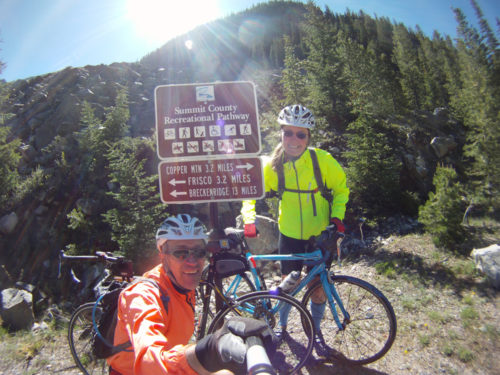
D & A: With a number of tours under our belt, we’ve found ways to cope with our riding differences. On a bike tour, we usually ride at our own pace but regroup about every hour or at major turns or food stops so we don’t get too separated. Although I’d like to ride together it just doesn’t work for us. I’ve got a faster pace that feels comfortable for me and Angie has her own pace that is most efficient for her. Since I’m the stronger rider, I’ll carry more weight to compensate for our differences to keep us closer together.
Each morning we’ll discuss each leg and rally points throughout the day. We’re both prepared to travel independently by carrying everything we need such as a map, water filter (if needed), tools, snacks, etc. Good meeting places are convenience and grocery stores and restaurants. Since I’m usually in the lead I’ll lock my bike to a pole close to the road when I find a nice place to stop so Angie will know where I am and find me. She can usually find me because I’ll be in the shade or inside someplace with air conditioning.
C.U.: I’m surprised that you don’t ride together, aren’t you worried about Angie’s safety.
D & A: Well sure I worry about Angie but she’s not any safer riding next to me. The world isn’t as dangerous as the media would like you to believe. According to the evening news the world is full of murder, crime and mayhem. For a story to be news worthy it has to be an unusual event, the scarier the better. Random bikers are more of a nuisance than a crime opportunity. In normal everyday life, people are generally kind and considerate and they are not out to kill anyone. On the other hand, a dog bit Angie when she was riding on one occasion, but that didn’t make the evening news and Angie got a few stitches and a nice story out of it.
C.U.: Day to day decisions for couples or groups that travel by bike is frequent and can result in daily frictions. Can you discuss how you and Angie deal with decision making as a couple.
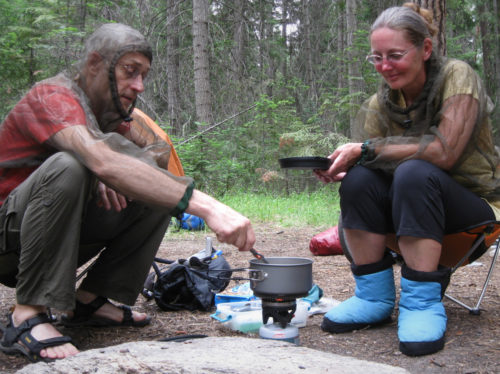
D & A: There are a lot of decisions to make on a bike tour and those decisions can be difficult under normal circumstances. When traveling alone, my own decisions over what I want to do and what I’m capable of based on how much I’m willing to suffer are difficult enough to make. With two people the decision making process is twice as complicated. It should be easy to make a logical decision but when you factor in different personalities and emotions it is really difficult to make a good plan that will make everyone happy. Sometimes I’ll try to guess what will make Angie happy while she’s trying to make a decision based on what she thinks I want. We are both pretty strong willed. I’m never wrong while Angie is always right.
It is a lot easier to make decisions earlier in the day before fatigue, hunger, heat, thirst and a sore butt complicate the issues. Try to decide daily distances based on current fitness levels against road conditions, elevation gains, weather and traffic. Some days will be harder or easier than others. Figure out rest stops, food stops and campsites understanding that any decision can change if conditions change or if the route is a little more or less difficult than expected. For us, we are usually on the road between 7 to 9 hours a day. That is normally 5 to 8 hours of peddling and 1 to 3 hours of stops and rests. That amount of riding can really tire a person out and stress a relationship. Not only does the physical work out tire the body but it also tires the mind. If the daily stress becomes too much, then we can decrease our daily millage or take a rest day.
C.U.: You are known for your early starts when touring. What is your schedule like for the day?
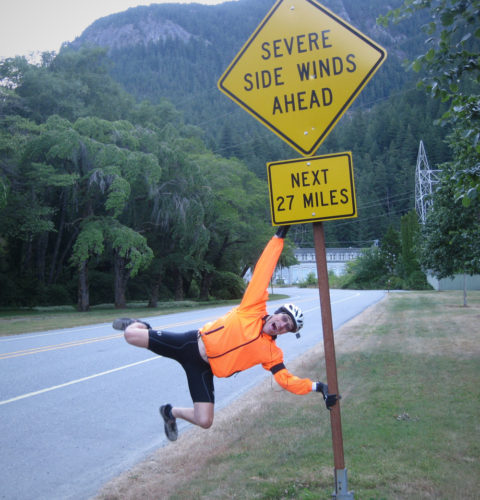
D & A: We have found that it is much nicer to start early in the day to take advantage of cooler temperatures and less traffic. It can be hard to wake early but after a day or two you get used to it and the benefits outweigh the discomforts. We can ride a lot more comfortably at 60 degrees than 90 degrees with a lot less water. As an added incentive, we like to plan our overnight stops about an hour away from a nice breakfast restaurant. It is wonderful way to start the day a little early with a little work out before a hot breakfast to power us through to lunch. Besides, breakfast is generally the cheapest meal to buy. Angie also likes to end the day of riding around 5pm or so. It gives her time to unwind, chill, read her book, and enjoy a relaxed evening meal before it gets dark.
C.U.: You mostly camp but utilize motels as well. What is your “routine” for lodging?
D & A.: On our bike tours, the majority of nights are spent camping and, depending on where we’re at, we’ll either wild camp or camp at a commercial campground. I really prefer to pitch the tent away from everyone…it’s quieter and much more enjoyable. If at all possible, I like to camp far away from motor homes with their noisy generators. And while we don’t have a set routine for setting up camp, we’ve been doing this so much that we know what needs to be done and we just do it…no need for discussion. We have a 3-person tent (vital for 2 people), really good sleeping bags and air pads. And since Angie likes to hotel it, we’ll stay in one about once a week or so, again depending on the route and sometimes if we know bad weather is coming in. Flexibility is the key. In fact, on our last trip, we set up our tent on the widest shoulder we could find just before an afternoon thunderstorm ambushed us. It was on one of the pullouts on a single-lane, gravel Forest Service Road on a long, steep mountain climb. So, instead of getting soaked, we spent the evening warm and dry while the storm raged outside our tent.
C.U.: You talk about the problems associated with fatigue. What are some of the ways that you deal with fatigue other than the rest days that you mentioned?
D & A: One of the biggest helps on multiday rides is to eat and drink regularly throughout the day. Eat something every hour; power bars, fruit, trail mix, candy. Even if your brain doesn’t want to eat, your body needs it, so force yourself to eat. If you stop at a convenience store load up on snacks and as much ice water as you can. Cold water during the ride tastes great and helps keep your core temperature down. Also, don’t forget to replace your electrolytes with an occasional sport drink.
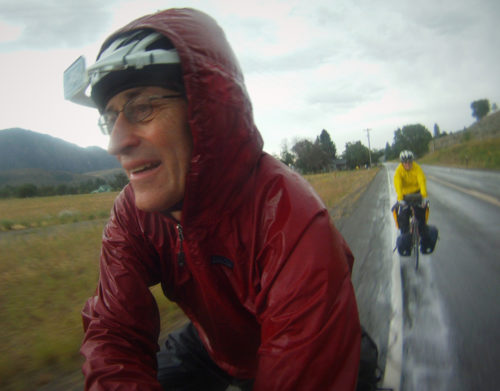
I’ve also found that taking caffeine pills (about 100 milligrams) about every hour or so helps alleviate mental fatigue. It really makes a big difference and can increase your performance. Caffeine pills are normally 200 milligrams so bite one in half to get a 100-milligram dose. Just don’t take caffeine on an empty stomach. Also, too much caffeine could make you jittery and very talkative but you’ll bike really, really fast.
C.U.: During your bike tours what keeps the two of you from riding, such as bad weather, illness or mental and physical fatigue?
D & A: We try not to ride in the rain if we can help it. Usually we are not on a schedule so, if it looks like a big weather system, we’ll wait it out in a hotel. Generally, it doesn’t rain all day so we can ride between small storms. There have been days on supported rides where we have to keep up with the group so we are forced to ride in the rain. If it is a warm rain, 70 degrees or above, it’s not too bad as long as you can dry off when you stop. If it is a cold rain, rain gear will make you sweat so much that you get wet anyway.
We always get mentally and physically trashed on long days of riding so Angie likes to take a rest day or, at least, take an easy day once a week. There are always the little annoyances that we just ride through. Things like sore butts or muscle aches. For sore butts there is Chamois Butt’r during the ride and A & D Ointment for over-night sores, the stuff in the brown tube not the blue. Muscle aches can be treated with Ibuprofen. On our Idaho Hot Sprigs trip this year, we had to stop for a couple of days because Angie came down with strep throat. Fortunately there was a clinic near by that shot her up with antibiotics so she recovered pretty quickly.
C.U.: What are some tips you can give the readers to make a bike tour pleasurable for a couple that is contemplating doing a bike tour?
D & A: Get an Alite Monarch Butterfly Chair. It is light enough for bike packing and its 2 rubber feet lets you rock back and forth to relax. You can also lean against a tree to sleep. At night, flip it over in the tent for a backrest. I know that you and Julie use REI chairs with four legs but the feet are smaller so they sink into loose soil, though a drink coaster could resolve that.
C.U.: I know that you are one of the few that have at times toured with a trailer and at other times with panniers. Do you have a preference? What are the pros and cons in your experience with each?
D & A: Almost everybody uses panniers but I love my BOB Trailer. Its low profile offers less wind drag then panniers and I like having everything in one place. If we are using trains or planes then panniers are more convenient but it takes a few days to figure out a packing system to find the things you need without looking through all four panniers.
C.U.: Any words of wisdom for other couples?
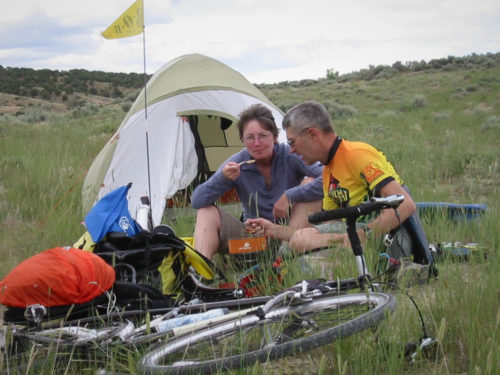
D & A: Bike touring is all about appreciating the journey which gets better when you have a partner to experience it with. Riding with a partner calls for compromises…and just like a marriage; the give and take is ever changing. When the ride is completed, the minor spats we have (and we always have them) are soon forgotten and we begin talking about our next ride! In fact, we’re already planning on riding Bike Route 66 (another Adventure Cycling Association route) next summer. It will be a 2400+-mile road bike tour from Santa Monica, CA to Chicago, IL.




